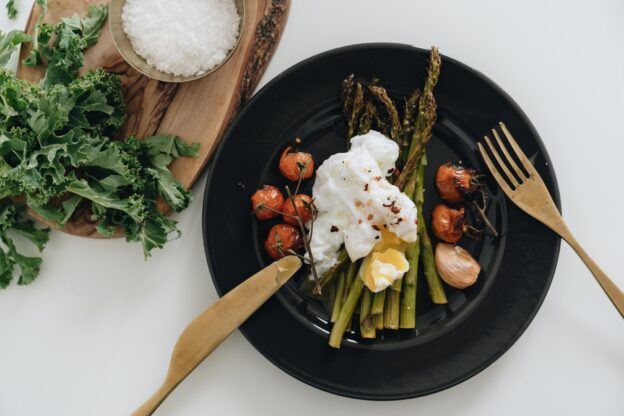Explaining to your clients why supporting their liver health is so important can be lengthy. In short, you can highlight how the liver is responsible for billions of vital enzymatic functions and biological processes occurring every second of every day, impacting how your clients look, feel, function and age.
But a key component is fat. To be precise hepatic fat. Too much of this and those billions of cellular processes that occur simultaneously which rely on the liver are thrown off balance – and one thing we know about the body is it likes to be balanced (A.K.A homeostasis).
The NHS refers to a high content of hepatic fat within the liver as non-alcoholic fatty liver disease (NAFLD) and suggests it’s affecting every 1 in 3 people in the UK.
This predominantly effects anyone who experiences high cholesterol or a metabolic syndrome, for example, T2D or diabetes, high blood pressure or obesity, but is not limited to these factors. However, since hepatic fat lurks in the liver it is technically an invisible fat that affects people of all shapes and sizes, meaning it is not just associated with a high BMI or waist to hip ratio. Event athletes must be cautious of a high hepatic fat content. Common signs of an unhealthy liver are fatigue, headaches, allergies, bad breath, skin problems, low mood and weight gain.
This article is a reminder to all health professionals on liver function, which compounds are good and which are bad and how through precision nutrition and lifestyle tips you can support your clients taking the elénzia holistic approach to improve liver function.
Why is the liver so important?
The liver is one of the largest and most important organs in the body. A few of its main functions are:
- Metabolic — glucose homeostasis
- Synthetic — interconversion of nutrients, binding protein for iron, copper and vitamins
- Storage — of vitamins and minerals, glycogen, and lipids
- Catabolic — detoxification, phagocytosis [bacterial metabolism], hormones, synthesis of blood components
- Excretory — bile production

Its main role – DETOXIFICATION
A key role of the liver is detoxification. Substances ingested or produced by the body (a by-product of metabolism) will eventually get filtered through the liver in two phases:
Phase I
The first phase is where the body draws in stored fat-soluble toxins from the body’s tissues. These toxins enter the body (via food, mouth, nose or skin) and if allowed to pass the barrier of the intestine make their way into the bloodstream. They are the last thing you would ever want to float around in the cardiovascular system and therefore they are stored away in fat, nerves, brain, and kidney tissues until they can be properly and safely disposed of.
Phase II
Phase II is where the body takes these toxins and prepares them for their exit; a water molecule is added to each fat-soluble chemical allowing them to depart the body safely.
What gets detoxified?
Phase I
Phase I detoxifies drugs such as: codeine, warfarin, prednisone, steroids and alcohol. For these toxins to be cleared out certain nutrients are required – for example, copper, magnesium, zinc, vitamin C, molybdenum, antioxidants and bioflavonoids. Further, the phase I process is activated or inhibited by certain foods, compounds or substances and these need to be balanced.
Foods and other things that turn on Phase I (Activators)
Broccoli, cabbage, brussels sprouts, caraway, dill seeds, oranges, tangerines, vitamin B1, niacin, vitamin C, charbroiled meats, alcohol, nicotine, some drugs, chemicals, dioxin, pesticides.
Foods and other things that turn off Phase I (Inhibitors)
Drugs including antihistamines, stomach acid blockers, ketoconazole, naringenin (from grapefruit juice), turmeric, green tea, red chilli pepper, clove oil, onions (quercetin), calendula, milk thistle, ageing, hypothyroidism, toxins from inappropriate intestinal bacteria.
The liver must function in a balance. If Phase I is functioning either too quickly or too slowly its detox potential will not be there and instead of filtering chemicals out of the body they will be absorbed back into the body’s cells. To help your clients assess if Phase I is functioning optimally you can recommend they try a caffeine clearance test.
Phase II
Phase II is the second part of liver detoxification. This is where the liver detoxifies drugs such as: paracetamol, nicotine, caffeine, pesticides, epoxides, aspirin and benzoates. Again, for these toxins to be cleared out certain nutrients are required – for example, glutathione, vitamin B6, glycine, SAMe, methyl groups, molybdenum, cysteine and acetyl CoA etc. Further, the Phase II process is activated or inhibited by certain foods, compounds or substances and these need to be balanced.
Foods and other things that turn on Phase II (Activators)
Brassica family foods, limonene (found in the peel of citrus fruits, as well as herbs dill and caraway), glycine, methyl donators, taurine and fish oils, birth control pill and some drugs.
Foods and other things that turn off Phase II (Inhibitors)
A deficiency of glutathione, folic acid, Vitamin B1, B2, B5 and B12, selenium or zinc. A diet low in protein.
The liver will do its best to break down toxic substances into less toxic forms that can be easily eliminated from the body. However, if one of the phases of detoxification is working either too quickly or too slowly due to deficiencies in nutrients, an imbalanced diet or a high intake of medication, many of the toxins that enter the body will not be cleared out properly and those that cannot be eliminated will be stored in the liver and in other tissues throughout the body.
Phase I and II combined
If Phase I is moving too quickly and Phase II is working too slowly, it will not be able to keep up with the demand of Phase I and some toxins may be let into the body, the same can occur if Phase II is working faster than Phase I, as it may not process chemicals as effectively. Again, you can recommend clients try a caffeine clearance test to assess how well their liver is functioning across both phases.
How to improve liver function
It is said that life depends upon the liver! The liver does many functions like storing nutrients, cleansing the blood, and managing the cholesterol. However, as mentioned the one thing that slows this all down is its fat content. Too high and those all-important Phases I and II are thrown off track. This makes it very important for the overall health of the body.
Fortunately, there are some foods and nutritional compounds that can a) help you keep the fat content low and b) support Phases I and II. For example, highly potent nutritional compounds such as astaxanthin have been shown to target, repair and prevent tissue damage which will assist the liver in detoxification. Other foods that have ample amounts of magnesium, folate, iron, flavonoids and vitamins reduce the risk of deficiency in the essential nutrients required for the indirect processes supporting enzymatic detoxification processes. Further, some botanical compounds such as thymoquinone – the potent active compound found in black seed oil – can help to convert hepatic fat cells to be utilised as energy.
Naturally, the combination of all these components makes up the perfect recipe to support liver detoxification process which in turn supports overall health.
How to ensure your clients follow the perfect liver health recipe
Below we list some of the recommendations you can offer clients whose liver need some TLC.
Healthy habits for a healthy liver:
- Chew your food properly and don’t just swallow it
- Do not have food that does not go well with your liver
- Cut down on coffee and tea intake
- Try to drink an adequate amount of water
- Avoid using antibiotics and antacids as far as possible
- Cut down on the sugar and salt intake to keep your body healthy
- Go slow on alcohol
- Quit smoking
- Take up some form of exercise like yoga. Certain twist positions in yoga are designed purely to enhance blood flow to and from the liver improving its function.
- Ensure adequate good quality sleep. The liver works the hardest between 11pm and 3am. Therefore, it is best to supplement for your liver immediately after an evening meal which ideally should be no later than 6pm.
- Reduce stress and cortisol levels. Stressors vary from person to person but stress effects the liver all the same. Therefore, reducing stress is key to improving liver health so advising people to try meditation, or breathing exercises is always a good start and removing what triggers stress away from their daily life. Trying apps such as Calm or Waking Up is always a good start.
Supplementing botanicals to support a healthy liver which are hard to source through diet alone:

List of foods to incorporate in diet plans for your clients:
Cruciferous vegetables
Some common cruciferous vegetables are broccoli, cauliflower, brussels sprouts, cabbage etc. They are strong detoxifiers of our liver as they contain certain chemicals which neutralize toxins. They also help in the production of enzymes needed for detoxification.
Beetroot
Beetroot should be included in the diet for a healthy liver. It contains blood-purifying properties to clean the blood and absorb any heavy metals.
Onions and garlic
Garlic has allicin which is needed for detoxification by the liver. It helps the liver to get rid of the mercury, oestrogen and food additives. Onions and garlic are also very good at supporting the liver around the menstrual cycle.
Apples
Apple has pectin which binds itself to the heavy metals and helps in their excretion. This reduces the burden on the liver.
Lemon juice in hot water
Lemon juice provides a large quantity of vitamin C and influences the production of bile. By increasing the bile flow the liver becomes more effective in cleansing the blood and removing unwanted substances.
Artichoke
Artichoke also increases the bile production. Bile removes the toxins and harmful micro-organisms from the body through healthy bowel movement.
Fruits with high anti-oxidants
Like astaxanthin, anti-oxidants from fruits protect the liver from the free radicals which are produced during the detoxification. These free radicals are harmful to the body. Some suggested fruits are prunes, blueberries, plums, oranges, pears, cantaloupes etc.
Bitter salad greens
The bitterness present in the leafy greens helps in the stimulation of bile in the liver. Some bitter salad greens are chicory, dandelion, endive etc. All the above-given foods should be a part of a diet for a healthy liver.
For more information on helping your client’s liver health, one to one product training or client case study training, feel free to get in touch at christie@elenzia.com.
References
- Marieb, E.N. (2012). Essentials of Human Anatomy and Physiology (10th ed). San Francisco, CA: Pearson Education, Inc.
- Regan, J., Russo, A., Seeley, R., & Van Putte, C. (2011). Seeley’s Anatomy & Physiology (9th ed). New York, NY: McGraw-Hill Companies Inc.
- Demeda, P. (2014). Lecture on Clinical Detoxification. Personal Collection of P. Demeda, Institute of Holistic Nutrition, Mississauga Ontario.
- Holford, P. (2004). The Optimal Nutrition Bible. London: Piatkus.










